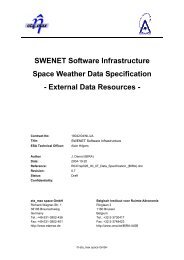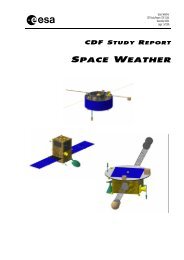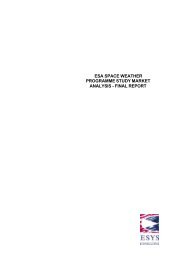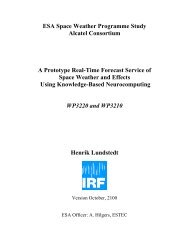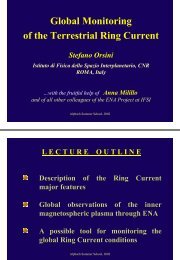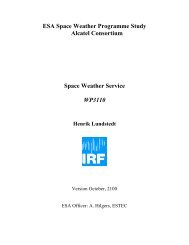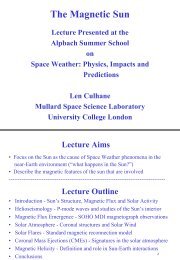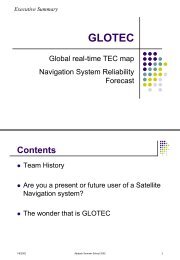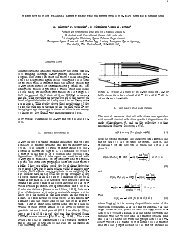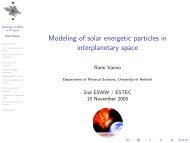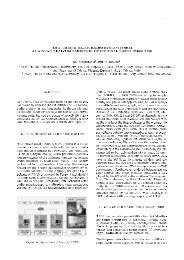Effects on Satellite Communications and Navigation - ESA Space ...
Effects on Satellite Communications and Navigation - ESA Space ...
Effects on Satellite Communications and Navigation - ESA Space ...
Create successful ePaper yourself
Turn your PDF publications into a flip-book with our unique Google optimized e-Paper software.
References<br />
K. Davies, “I<strong>on</strong>ospheric Radio”, Peter Peregrinus Ltd, 1990, ISBN 0 86341 186X<br />
R. Leitinger, S. Radicella, B. Nava, G. Hochegger <strong>and</strong> J. Hafner, “NeQuick- COSTprof –NEUOG-<br />
Plas, a family of 3D electr<strong>on</strong> density models” Proceedings of the 4th COST 251 Workshop ‘The<br />
impact of the Upper Atmosphere <strong>on</strong> Terrestrial & Earth-<strong>Space</strong> Communicati<strong>on</strong>s”, Funchal,<br />
Madeira, Portugal, 1999, 75.<br />
ITU-R Rec. P.371-8 “Choice of Indices for L<strong>on</strong>g-term I<strong>on</strong>ospheric Predicti<strong>on</strong>s”, Geneva 1999<br />
ITU-R Rec. P.531-6 “I<strong>on</strong>ospheric propagati<strong>on</strong> data <strong>and</strong> predicti<strong>on</strong> methods required for the<br />
design of satellite services <strong>and</strong> systems”, Geneva 2001<br />
ITU-R Rec. P.1239 “ITU-R Reference i<strong>on</strong>ospheric characteristics”, Geneva 1997<br />
D. N. Baker, J. H. Allen, S. G. Kanekal, <strong>and</strong> G. D. Reeves, “Pager <strong>Satellite</strong> Failure May Have<br />
Been Related to Disturbed <strong>Space</strong> Envir<strong>on</strong>ment”, EOS, October 1998, p. 477.<br />
ESTEC Final Report Co 14069, “European <strong>Space</strong> Weather Programme System Requirements<br />
Definiti<strong>on</strong>”, DERA, April 2001<br />
2002-07-29 ALPBACH 23<br />
Glossary – Acr<strong>on</strong>yms - Abbreviati<strong>on</strong>s<br />
Cor<strong>on</strong>al mass ejecti<strong>on</strong> --large clouds of material expelled from the Sun. These often travel away from the Sun at very high speeds (<strong>on</strong>e<br />
to two milli<strong>on</strong> miles per hour), especially near sunspot activity maximum. They can c<strong>on</strong>tain 10 15 grams (or more) of solar material;<br />
Fluence --the number of particles that hit a given area (say a square centimeter) of a spacecraft over a given unit of time. For example, we<br />
are often interested in how many 1 milli<strong>on</strong> electr<strong>on</strong> Volt particles hit a cm 2 of spacecraft each day in space: this would be the "daily fluence"<br />
of >1MeV electr<strong>on</strong>s;<br />
GEO (GEOstati<strong>on</strong>ary orbit)--the special orbit above the Earth's equator that is at an altitude of 35,600 km. A GEO satellite appears to move<br />
at the same angular speed as the Earth turns - it stays above the same spot <strong>on</strong> the Earth;<br />
GPS -- Global Positi<strong>on</strong>ing System<br />
HEO (Highly Elliptical Orbit) -- an elliptical orbit with perigee < 3000 km <strong>and</strong> apogee > 30000 km<br />
LEO (Low Earth Orbit) -- a circular orbit with an altitude of 200 to 1500 km<br />
Magnetosphere--the uppermost part of the Earth's atmosphere. This regi<strong>on</strong> is populated by a very tenuous gas (1 to 1000 particles per<br />
cubic centimeter) made up mostly of electr<strong>on</strong>s, prot<strong>on</strong>s, <strong>and</strong> atomic nuclei (such as charged oxygen that has moved up from the lower<br />
atmosphere), all c<strong>on</strong>trolled by the Earth's magnetic field;<br />
SBAS – <strong>Satellite</strong> Based Augmentati<strong>on</strong> Systems such as WAAS or EGNOS are providing GPS receivers with wide area differential<br />
correcti<strong>on</strong> plus integrity by means of a network of reference stati<strong>on</strong>s <strong>and</strong> geostati<strong>on</strong>ary satellites which broadcast the message.<br />
Solar flares--the occasi<strong>on</strong>al, powerful energy bursts that occur <strong>on</strong> the Sun's surface. These often occur in the form of X rays, radio<br />
emissi<strong>on</strong>s, <strong>and</strong> powerful bursts of very high energy particles;<br />
Solar wind--the hot, exp<strong>and</strong>ing gas of charged particles that flow away from the Sun toward the cold void of interstellar space. The solar<br />
wind c<strong>on</strong>tains i<strong>on</strong>s, electr<strong>on</strong>s, <strong>and</strong> magnetic fields.<br />
UERE – User Equivalent Range Error<br />
2002-07-29 ALPBACH 24



